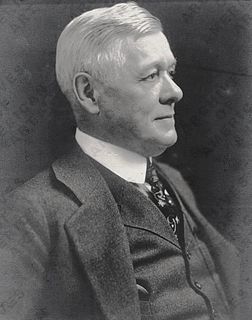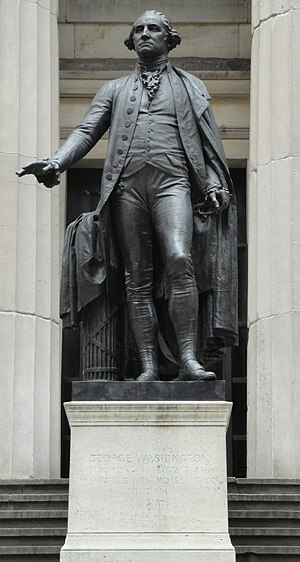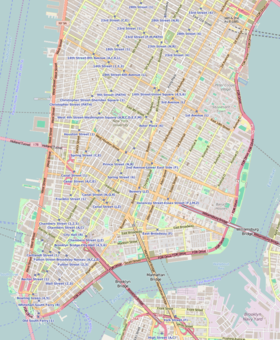
Daniel Chester French, one of the most prolific and acclaimed American sculptors of the late nineteenth and early twentieth centuries, is best known for his design of the monumental statue of Abraham Lincoln (1920) in the Lincoln Memorial, Washington, DC.

Bowling Green is a small public park in the Financial District of Lower Manhattan, New York City, at the southern end of Broadway. Located next to the site of the original Dutch fort of New Amsterdam, it served as a public place before being designated as a park in 1733. It is the oldest public park in New York City and is surrounded by its original 18th-century fence. It originally included an actual bowling green and an equestrian statue of King George III prior to the American Revolution.

Federal Hall is the name given to the first of two historic buildings located at 26 Wall Street in the Financial District of Manhattan, New York City. The original, a Federal style structure completed in 1703, served as New York's first City Hall. It was the site where the colonial Stamp Act Congress met to draft its message to King George III claiming entitlement to the same rights as the residents of Britain and protesting "taxation without representation".

John Quincy Adams Ward was an American sculptor, whose most familiar work is his larger than life-size standing statue of George Washington on the steps of Federal Hall National Memorial in New York City.

Charles Henry Niehaus, was an American sculptor.
George Washington (1732–1799) was the first President of the United States.

James Edward Kelly was an American sculptor and illustrator who specialized in depicting people and events of American wars, particularly the American Civil War.

City Hall Park is a public park surrounding New York City Hall in the Civic Center of Manhattan. It was the town commons of the nascent city of New York.

John Massey Rhind was a Scottish-American sculptor. Among Rhind's better known works is the marble statue of Dr. Crawford W. Long located in the National Statuary Hall Collection in Washington D.C. (1926).

Samuel Sullivan "Sunset" Cox was an American Congressman and diplomat. He represented both Ohio and New York in the United States House of Representatives, and also served as United States Ambassador to the Ottoman Empire.

The Greenwich Savings Bank was an American savings bank based in New York City that operated from 1833 to 1981. At the time of its closure in 1981, it was the 16th largest bank in the U.S. by total deposits.

Joseph Alexis Bailly was an American sculptor who spent most of his career in Philadelphia, Pennsylvania. He taught briefly at the Pennsylvania Academy of the Fine Arts, which has a collection of his sculpture. His most famous work is the statue of George Washington in front of Independence Hall.

Major General George Henry Thomas, also known as the Thomas Circle Monument, is an equestrian sculpture in Washington, D.C. that honors Civil War general George Henry Thomas. The monument is located in the center of Thomas Circle, on the border of the downtown and Logan Circle neighborhoods. It was sculpted by John Quincy Adams Ward, best known for his work on the George Washington statue. Attendees at the dedication in 1879 included President Rutherford B. Hayes, Generals Irvin McDowell, Philip Sheridan, and William Tecumseh Sherman, senators and thousands of soldiers.

The statue of John Aaron Rawlins, a United States Army general who served during the Civil War and later as Secretary of War, is a focal point of Rawlins Park, a small public park in Washington, D.C.'s Foggy Bottom neighborhood. It was installed in 1874, but relocated several times between 1880 and 1931. The statue was sculpted by French-American artist Joseph A. Bailly, whose best known work is the statue of George Washington in front of Independence Hall in Philadelphia.

George Dudley Seymour was an American historian, patent attorney, antiquarian, author, and city planner.















